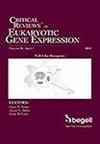SLC7A2-mediated lysine catabolism inhibits immunosuppression in triple negative breast cancer
IF 1.5
4区 医学
Q4 BIOTECHNOLOGY & APPLIED MICROBIOLOGY
Critical Reviews in Eukaryotic Gene Expression
Pub Date : 2024-02-01
DOI:10.1615/critreveukaryotgeneexpr.2024052503
引用次数: 0
Abstract
Breast cancer is one of the most common malignancy worldwide. SLC7A2 is abnormally expressed in multi-type cancers. However, the potentials of SLC7A2 in tripe negative breast cancer (TNBC) are still unclear. This study aimed to investigate the roles of SLC7A2 and the underlying molecular mechanisms. mRNA expression was detected by RT-qPCR. The release of cytokines was detected using ELISA. Protein expression was detected by western blot. Histone crotonylation was performed using in vitro histone crotonylation assay. functional analysis was performed using CCCK-8 and flow cytometry assay. Xenografting assay was conducted to further verify the roles of SLC7A2 in TNBC. The expression of CD8A was detected using immunohistochemistry. SLC7A2 was downregulated in TNBC tumors. Low levels of SLC7A2 were associated with advanced stages and lymph node metastasis. SLC7A2 expression was positive correlated with CD8A. SLC7A2-mediated lysine catabolism drove the activation of CD8+ T cells. Moreover, SLC7A2 promoted the histone crotonylationvia upregulating ACOX1 and downregulated CDYL. SLC7A2 promoted the interaction between ACOX1 and TCF1, resulting the proliferation of CD8+ T cells. Additionally, overexpression of SLC7A2 activated CD8+ T cells and enhanced the chemosensitivity of anti-PD-1 therapies in vivo. SLC7A2 may function as an anti-tumor gene in TNBC via activating anti-tumor immunity. Therefore, SLC7A2/ ACOX1/TCF1 signaling may be promising strategy for TNBC.SLC7A2- 介导的赖氨酸分解抑制了三阴性乳腺癌的免疫抑制作用
乳腺癌是全球最常见的恶性肿瘤之一。SLC7A2 在多种类型的癌症中都有异常表达。然而,SLC7A2在三阴性乳腺癌(TNBC)中的潜在作用尚不清楚。本研究旨在探讨 SLC7A2 的作用及其潜在的分子机制。使用 ELISA 检测细胞因子的释放。蛋白表达采用 Western 印迹法检测。使用 CCCK-8 和流式细胞仪进行功能分析。为了进一步验证 SLC7A2 在 TNBC 中的作用,进行了异种移植试验。免疫组化法检测了 CD8A 的表达。SLC7A2在TNBC肿瘤中下调。低水平的SLC7A2与晚期和淋巴结转移有关。SLC7A2的表达与CD8A呈正相关。SLC7A2介导的赖氨酸分解促进了CD8+ T细胞的活化。此外,SLC7A2通过上调ACOX1和下调CDYL促进组蛋白的巴豆酰化。SLC7A2 促进了 ACOX1 和 TCF1 之间的相互作用,从而导致了 CD8+ T 细胞的增殖。此外,过表达 SLC7A2 能激活 CD8+ T 细胞,增强体内抗 PD-1 疗法的化学敏感性。SLC7A2可能通过激活抗肿瘤免疫而在TNBC中发挥抗肿瘤基因的功能。因此,SLC7A2/ ACOX1/TCF1信号转导可能是治疗TNBC的有效策略。
本文章由计算机程序翻译,如有差异,请以英文原文为准。
求助全文
约1分钟内获得全文
求助全文
来源期刊

Critical Reviews in Eukaryotic Gene Expression
生物-生物工程与应用微生物
CiteScore
2.70
自引率
0.00%
发文量
67
审稿时长
1 months
期刊介绍:
Critical ReviewsTM in Eukaryotic Gene Expression presents timely concepts and experimental approaches that are contributing to rapid advances in our mechanistic understanding of gene regulation, organization, and structure within the contexts of biological control and the diagnosis/treatment of disease. The journal provides in-depth critical reviews, on well-defined topics of immediate interest, written by recognized specialists in the field. Extensive literature citations provide a comprehensive information resource.
Reviews are developed from an historical perspective and suggest directions that can be anticipated. Strengths as well as limitations of methodologies and experimental strategies are considered.
 求助内容:
求助内容: 应助结果提醒方式:
应助结果提醒方式:


